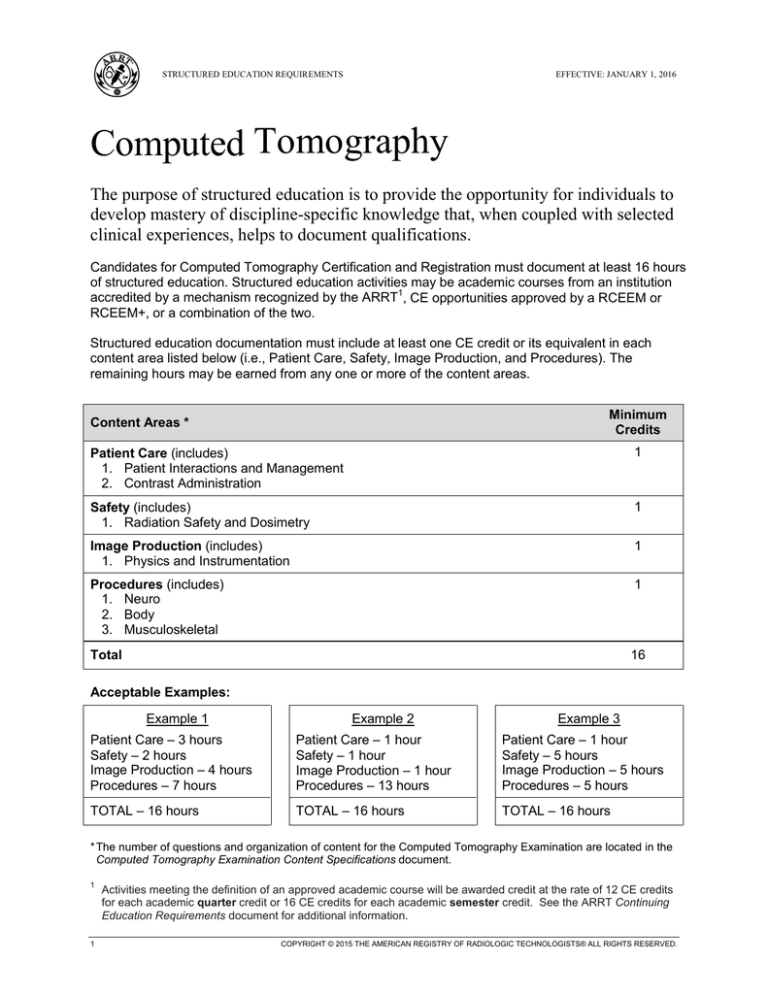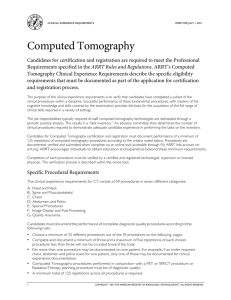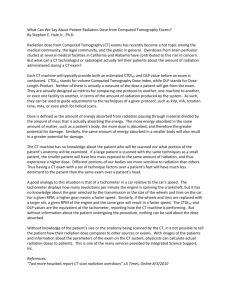
STRUCTURED EDUCATION REQUIREMENTS
EFFECTIVE: JANUARY 1, 2016
Computed Tomography
The purpose of structured education is to provide the opportunity for individuals to
develop mastery of discipline-specific knowledge that, when coupled with selected
clinical experiences, helps to document qualifications.
Candidates for Computed Tomography Certification and Registration must document at least 16 hours
of structured education. Structured education activities may be academic courses from an institution
accredited by a mechanism recognized by the ARRT1, CE opportunities approved by a RCEEM or
RCEEM+, or a combination of the two.
Structured education documentation must include at least one CE credit or its equivalent in each
content area listed below (i.e., Patient Care, Safety, Image Production, and Procedures). The
remaining hours may be earned from any one or more of the content areas.
Minimum
Credits
Content Areas *
Patient Care (includes)
1. Patient Interactions and Management
2. Contrast Administration
1
Safety (includes)
1. Radiation Safety and Dosimetry
1
Image Production (includes)
1. Physics and Instrumentation
1
Procedures (includes)
1. Neuro
2. Body
3. Musculoskeletal
1
Total
16
Acceptable Examples:
Example 1
Example 2
Example 3
Patient Care – 3 hours
Safety – 2 hours
Image Production – 4 hours
Procedures – 7 hours
Patient Care – 1 hour
Safety – 1 hour
Image Production – 1 hour
Procedures – 13 hours
Patient Care – 1 hour
Safety – 5 hours
Image Production – 5 hours
Procedures – 5 hours
TOTAL – 16 hours
TOTAL – 16 hours
TOTAL – 16 hours
* The number of questions and organization of content for the Computed Tomography Examination are located in the
Computed Tomography Examination Content Specifications document.
1
1
Activities meeting the definition of an approved academic course will be awarded credit at the rate of 12 CE credits
for each academic quarter credit or 16 CE credits for each academic semester credit. See the ARRT Continuing
Education Requirements document for additional information.
COPYRIGHT © 2015 THE AMERICAN REGISTRY OF RADIOLOGIC TECHNOLOGISTS® ALL RIGHTS RESERVED.
COMPUTED TOMOGRAPHY
STRUCTURED EDUCATION REQUIREMENTS
EFFECTIVE: JANUARY 1, 2016
Patient Care
1. Patient Interactions and Management
A. Clinical History
B. Scheduling and Screening
C. Education
D. Consent
E. Immobilization
F. Monitoring
1.
2.
3.
4.
level of consciousness
vital signs
heart rhythm and cardiac cycle
oximetry
G. Management of Accessory Medical
Devices
1. oxygen delivery systems
2. chest tubes
3. in-dwelling catheters
H. Lab Values
1. renal function
(e.g., BUN, eGFR, creatinine)
2. blood coagulation
(e.g., PT, PTT, platelet, INR)
3. other (e.g., D-dimer, LFT)
I. Medications and Dosage
1. current (reconciliation)
2. pre-procedure medications
(e.g., steroid, anti-anxiety)
3. post-procedure instructions
(e.g., diabetic patient)
2. Contrast Administration
A. Contrast Media
1.
2.
3.
4.
5.
6.
7.
ionic, nonionic
osmolarity
barium sulfate
water soluble (iodinated)
air
water
other
B. Special Contrast Considerations
1.
2.
3.
4.
5.
2
contraindications
indications
pregnancy
lactation
dialysis patients
C. Contrast Media
1.
2.
3.
4.
5.
6.
types of agents
indications
contraindications
dose calculation
administration route
scan/prep delay
(e.g., bolus timing, test bolus)
D. Administration Route and Dose
Calculations
1. IV
2. oral
3. rectal
4. intrathecal
5. catheters (e.g., peripheral line,
central line, PICC line)
6. other (e.g., stoma, intra-articular)
E. Venipuncture
1. site selection
2. aseptic and sterile technique
3. documentation (e.g., site, amount,
gauge, concentration, rate and
number of attempts)
F. Injection Techniques
1. manual
2. power injector options
a. single or dual head
b. single phase
c. multi-phase
d. flow rate
G. Post-Procedure Care
1. treatment of contrast extravasation
2. documentation
H. Adverse Reactions
1. recognition and assessment
2. treatment
3. documentation
COMPUTED TOMOGRAPHY
STRUCTURED EDUCATION REQUIREMENTS
EFFECTIVE: JANUARY 1, 2016
Safety
1. Radiation Safety and Dosimetry
A. Radiation Physics
D. Dose Measurement
B. Technical Factors Affecting Patient Dose
E. Patient Dose Reduction and
1. radiation interaction with matter
2. acquisition (geometry)
3. physical principles (attenuation)
1.
2.
3.
4.
5.
6.
kVp
mAs
pitch
collimation/beam width
multi-detector configuration
gating
C. Radiation Protection and Shielding
1. traditional (e.g., lead apron)
2. non-traditional (e.g., bismuth)
3
1. CT dose index (CTDI)
2. dose length product (DLP)
3. documentation
Optimization
1. pediatric
2. adult
3. dose modulation techniques
(e.g., SMART mA, auto mA,
CARE dose, and SURE
exposure)
4. iterative reconstruction
COMPUTED TOMOGRAPHY
STRUCTURED EDUCATION REQUIREMENTS
EFFECTIVE: JANUARY 1, 2016
Image Production
1. Physics and Instrumentation
A. CT System Principles, Operation and
Components
1. tube
a. kVp
b. mA
c. warm-up procedures
2. generator
3. detector configuration
4. data acquisition systems (DAS)
5. collimation/beam width
6. computer and array processor
B. Image Processing
1. reconstruction
a. filtered backprojection
reconstruction
b. iterative reconstruction
c. interpolation
d. reconstruction algorithm
e. raw data versus image data
f. prospective/retrospective
reconstruction
g. reconstruction interval
2. post-processing
a. multi-planar reformation (MPR)
b. 3D rendering (MIP, SSD, VR)
c. quantitative analysis
(e.g., distance, diameter, calcium
scoring, ejection fraction)
C. Imaging Processes
1. isocentric positioning
2. scout
3. acquisition methods
(e.g., volumetric, axial or sequential)
4. parameter selection
(e.g., image thickness, mA, time,
algorithm, pitch)
5. protocol modification for pathology
or trauma
4
D. Image Display
1. pixel, voxel
2. matrix
3. image magnification
4. field of view (scan, reconstruction,
and display)
5. window level, window width
6. cine
7. ROI (e.g., mean, standard deviation
[SD])
E. Informatics
1. hard/electronic copy
(e.g., DICOM file format)
2. archive
3. pacs
4. security and confidentiality
5. networking
F. Image Quality
1. spatial resolution
2. contrast resolution
3. temporal resolution
4. noise and uniformity
5. quality assurance
6. CT number (Hounsfield units)
7. linearity
G. Artifact Recognition and Reduction
1. beam hardening or cupping
2. partial volume averaging
3. motion
4. metallic
5. edge gradient
6. patient positioning (out-of-field)
7. equipment induced
a. rings
b. streaks
c. tube arcing
d. cone beam
e. capping
COMPUTED TOMOGRAPHY
STRUCTURED EDUCATION REQUIREMENTS
EFFECTIVE: JANUARY 1, 2016
Procedures
FOCUS OF QUESTIONS:
1. Neuro
A. Head
1. cranial nerves
2. internal auditory canal
3. temporal bones
4. pituitary
5. orbits
6. sinuses
7. maxillofacial
8. temporomandibular joint
9. posterior fossa
10. brain
11. cranium
12. vascular
B. Neck
1. larynx
2. soft tissue neck
3. vascular
2. Body
A. Chest
1. mediastinum
2. lung
3. heart
4. airway
5. vascular
B. Abdomen
1.
2.
3.
4.
5.
6.
7.
8.
liver
biliary
spleen
pancreas
adrenals
kidneys and/or ureters
GI tract
vascular
C. Pelvis
1.
2.
3.
4.
5
bladder
colorectal
reproductive organs
vascular
1. Sectional Anatomy
• sagittal plane
• transverse plane (axial)
• coronal plane
• off-axis (oblique)
• landmarks
• pathology recognition
2. Special Procedures
• 3D studies
• biopsies
• radiation therapy planning
• drainage
• colonography or virtual colonography
• brain perfusion studies
• transplant studies
• screening
(Procedures continue on the following page.)
COMPUTED TOMOGRAPHY
STRUCTURED EDUCATION REQUIREMENTS
EFFECTIVE: JANUARY 1, 2016
Procedures (continued)
3. Musculoskeletal
A. Upper Extremity
B. Lower Extremity
C. Spine
D. Pelvis and/or Hips
E. Shoulder Girdle
F. Sternum and/or Ribs
G. Vascular
H. Post Myelography
I. CT Arthrography
J. Diskography
6
FOCUS OF QUESTIONS:
1. Sectional Anatomy
• sagittal plane
• transverse plane (axial)
• coronal plane
• off-axis (oblique)
• landmarks
• pathology recognition
2. Special Procedures
• 3D studies
• biopsies
• radiation therapy planning
• drainage
• colonography or virtual colonography
• brain perfusion studies
• transplant studies
• screening
V 2015.06.12




